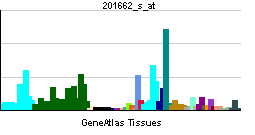ACSL3
| Acyl-CoA synthetase long-chain family member 3 | |||||||||||
|---|---|---|---|---|---|---|---|---|---|---|---|
| Identifiers | |||||||||||
| Symbols | ACSL3 ; ACS3; FACL3; PRO2194 | ||||||||||
| External IDs | Template:OMIM5 Template:MGI HomoloGene: 3278 | ||||||||||
| |||||||||||
| RNA expression pattern | |||||||||||
 | |||||||||||
 | |||||||||||
 | |||||||||||
| More reference expression data | |||||||||||
| Orthologs | |||||||||||
| Template:GNF Ortholog box | |||||||||||
| Species | Human | Mouse | |||||||||
| Entrez | n/a | n/a | |||||||||
| Ensembl | n/a | n/a | |||||||||
| UniProt | n/a | n/a | |||||||||
| RefSeq (mRNA) | n/a | n/a | |||||||||
| RefSeq (protein) | n/a | n/a | |||||||||
| Location (UCSC) | n/a | n/a | |||||||||
| PubMed search | n/a | n/a | |||||||||
Acyl-CoA synthetase long-chain family member 3, also known as ACSL3, is a human gene.[1]
The protein encoded by this gene is an isozyme of the long-chain fatty-acid-coenzyme A ligase family. Although differing in substrate specificity, subcellular localization, and tissue distribution, all isozymes of this family convert free long-chain fatty acids into fatty acyl-CoA esters, and thereby play a key role in lipid biosynthesis and fatty acid degradation. This isozyme is highly expressed in brain, and preferentially utilizes myristate, arachidonate, and eicosapentaenoate as substrates. The amino acid sequence of this isozyme is 92% identical to that of rat homolog. Two transcript variants encoding the same protein have been found for this gene.[1]
References
Further reading
- Brueton LA, van Herwerden L, Chotai KA, Winter RM (1992). "The mapping of a gene for craniosynostosis: evidence for linkage of the Saethre-Chotzen syndrome to distal chromosome 7p". J. Med. Genet. 29 (10): 681–5. PMID 1433226.
- Bakken AM, Farstad M, Holmsen H (1991). "Identity between palmitoyl-CoA synthetase and arachidonoyl-CoA synthetase in human platelet?". Biochem. J. 274 ( Pt 1): 145–52. PMID 1848073.
- Bronfman M, Inestrosa NC, Nervi FO, Leighton F (1985). "Acyl-CoA synthetase and the peroxisomal enzymes of beta-oxidation in human liver. Quantitative analysis of their subcellular localization". Biochem. J. 224 (3): 709–20. PMID 6240978.
- Rose CS, King AA, Summers D; et al. (1995). "Localization of the genetic locus for Saethre-Chotzen syndrome to a 6 cM region of chromosome 7 using four cases with apparently balanced translocations at 7p21.2". Hum. Mol. Genet. 3 (8): 1405–8. PMID 7987323.
- Fujino T, Kang MJ, Suzuki H; et al. (1996). "Molecular characterization and expression of rat acyl-CoA synthetase 3". J. Biol. Chem. 271 (28): 16748–52. PMID 8663269.
- Bonaldo MF, Lennon G, Soares MB (1997). "Normalization and subtraction: two approaches to facilitate gene discovery". Genome Res. 6 (9): 791–806. PMID 8889548.
- Minekura H, Fujino T, Kang MJ; et al. (1997). "Human acyl-coenzyme A synthetase 3 cDNA and localization of its gene (ACS3) to chromosome band 2q34-q35". Genomics. 42 (1): 180–1. doi:10.1006/geno.1997.4710. PMID 9177793.
- Minekura H, Kang MJ, Inagaki Y; et al. (2002). "Genomic organization and transcription units of the human acyl-CoA synthetase 3 gene". Gene. 278 (1–2): 185–92. PMID 11707336.
- Strausberg RL, Feingold EA, Grouse LH; et al. (2003). "Generation and initial analysis of more than 15,000 full-length human and mouse cDNA sequences". Proc. Natl. Acad. Sci. U.S.A. 99 (26): 16899–903. doi:10.1073/pnas.242603899. PMID 12477932.
- Ota T, Suzuki Y, Nishikawa T; et al. (2004). "Complete sequencing and characterization of 21,243 full-length human cDNAs". Nat. Genet. 36 (1): 40–5. doi:10.1038/ng1285. PMID 14702039.
- Mashek DG, Bornfeldt KE, Coleman RA; et al. (2005). "Revised nomenclature for the mammalian long-chain acyl-CoA synthetase gene family". J. Lipid Res. 45 (10): 1958–61. doi:10.1194/jlr.E400002-JLR200. PMID 15292367.
- Beausoleil SA, Jedrychowski M, Schwartz D; et al. (2004). "Large-scale characterization of HeLa cell nuclear phosphoproteins". Proc. Natl. Acad. Sci. U.S.A. 101 (33): 12130–5. doi:10.1073/pnas.0404720101. PMID 15302935.
- Gerhard DS, Wagner L, Feingold EA; et al. (2004). "The status, quality, and expansion of the NIH full-length cDNA project: the Mammalian Gene Collection (MGC)". Genome Res. 14 (10B): 2121–7. doi:10.1101/gr.2596504. PMID 15489334.
- Qiao S, Tuohimaa P (2005). "Vitamin D3 inhibits fatty acid synthase expression by stimulating the expression of long-chain fatty-acid-CoA ligase 3 in prostate cancer cells". FEBS Lett. 577 (3): 451–4. doi:10.1016/j.febslet.2004.10.044. PMID 15556626.
- Rohozinski J, Lamb DJ, Bishop CE (2006). "UTP14c is a recently acquired retrogene associated with spermatogenesis and fertility in man". Biol. Reprod. 74 (4): 644–51. doi:10.1095/biolreprod.105.046698. PMID 16354793.
- Tu LC, Yan X, Hood L, Lin B (2007). "Proteomics analysis of the interactome of N-myc downstream regulated gene 1 and its interactions with the androgen response program in prostate cancer cells". Mol. Cell Proteomics. 6 (4): 575–88. doi:10.1074/mcp.M600249-MCP200. PMID 17220478.
- Zhou Y, Abidi P, Kim A; et al. (2007). "Transcriptional activation of hepatic ACSL3 and ACSL5 by oncostatin m reduces hypertriglyceridemia through enhanced beta-oxidation". Arterioscler. Thromb. Vasc. Biol. 27 (10): 2198–205. doi:10.1161/ATVBAHA.107.148429. PMID 17761945.
| This protein-related article is a stub. You can help Wikipedia by expanding it. |